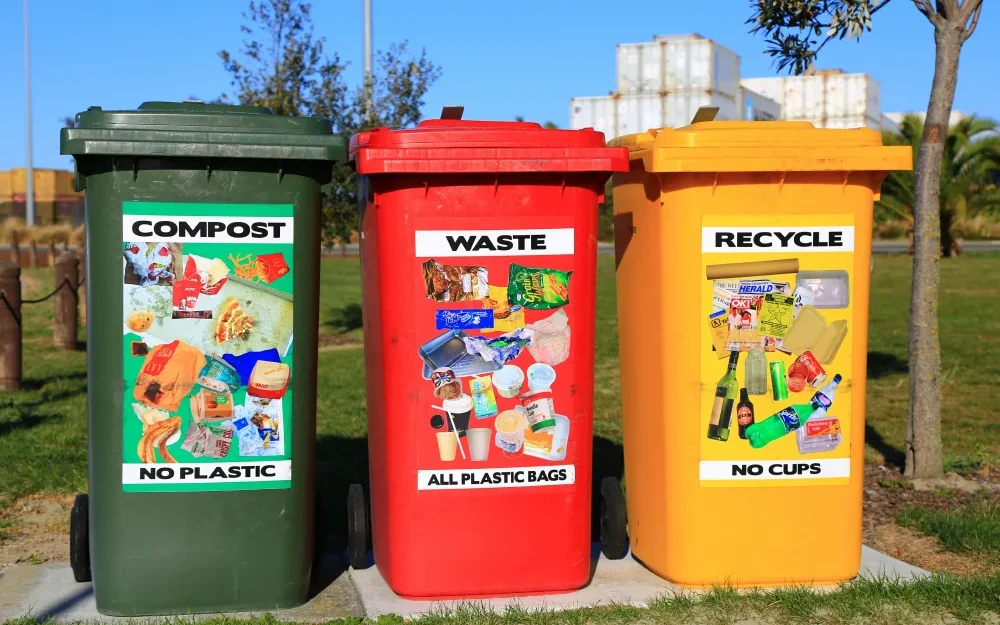Home Improvement Living in Texas
How Many Solar Panels Do You Need in Texas?
4 minute readHow to calculate the number of solar panels you need to power your Texas home
Home > BKV Energy Blog > All Posts > Is Recycling Worth It? Pros and Cons Explained
4 minute read • Last update July 2025

Did you know that the average American throws out about 4.9 pounds of waste every day? That equates to around 150 pounds of waste materials per month and nearly 1800 pounds annually per person.
With numbers like these, it’s no wonder recycling is often touted as the ultimate solution. But is it really? Or is recycling a waste of time?
In short, yes. The benefits of recycling generally outweigh the drawbacks. By reducing waste, living a more eco-friendly lifestyle, and making an effort to conserve natural resources, we can all contribute to creating a healthier planet and building a more sustainable future for future generations.
However, it’s essential to acknowledge that it’s not a magic solution, as recycling efforts alone cannot solve all our environmental problems. To learn more, let’s look into the advantages and disadvantages of recycling in depth.
Uncovering the truth about recycling requires a measured, unbiased, and comprehensive approach, so it’s essential to cover as many aspects as possible. We’ll start by examining recycling benefits in detail before moving on to look at the potential negative impacts of recycling programs.
The most commonly cited reasons to recycle include environmental benefits, economic factors, and energy conservation advantages.
Recycling reduces the amount of materials that end up in landfills, waste management facilities, and incinerators.
The recycling rate varies by different products across the United States, but without our recycling programs, our nation would be sending much more waste to landfills.
Here are a few examples from data reported in 2018 by the Environmental Protection Agency:
Recycling materials rather than throwing items away after use reduces the need to extract raw materials like timber, water, and minerals. For instance, recycling paper saves trees, while recycling plastic reduces the demand for crude oil.
Manufacturing products from recycled materials generally requires less energy than extracting raw materials to make new ones. For example, recycling aluminum cans reduces the energy required to extract resources like raw bauxite ore by 95%.
The energy consumption associated with an increased recycling rate helps lower carbon dioxide emissions — a significant step in combating the effects of climate change and global warming. The amount of materials recycled between 2020 and 2050 should equate to taking over one billion cars off the streets each year.
The recycling industry stimulates economic activity. But precisely how does recycling work in terms of generating revenue? The primary economic benefits lie in wages and taxes, which, in the US alone, are estimated to total around $117 billion annually.
Recycling facilities create employment opportunities worldwide in developed and developing countries alike. Here in the US, it’s estimated that recycling infrastructure creates nine times more jobs than trash.
Every recycling program, no matter how small, contributes to a more sustainable economy. Reducing consumption and reusing materials conserves finite resources, helping to sustain ecosystems and biodiversity.
By diverting recyclable materials away from landfills, negative environmental impacts like soil and water contamination can be minimized. Plus, when incineration rates drop there’s a notable air pollution reduction, which improves human health.
With all of those benefits considered, it’s hard to imagine that efforts to reduce waste may cause more harm than good. However, there are a few downsides to consider. Let’s examine the most commonly-cited cons of recycling to learn more.
Local authorities can find it challenging to reduce pollution, manage waste disposal effectively, and use public funds responsibly. For example, curbside recycling programs are estimated to cost $40 extra per household every year.
When not managed correctly, recycling certain materials can generate air pollution. The emissions from vehicles and equipment at recycling plants also produce air pollution, albeit in relatively small amounts.
Toxic materials may seep into land and waterways in close proximity to recycling bins and recycling facilities.
When non-recyclable materials are mixed in with recyclables, it can clog machines at the recycling facility, making processes less cost-effective and efficient. The top contaminants are plastic bags and associated items like shrink wrap and bubble wrap.
Is recycling plastic worth it? This is a common question due to significant grey areas surrounding the fate of plastic waste. A crucial issue is: does plastic really get recycled, or is it burned, shipped off to less developed countries, or simply sent to landfills? Addressing these concerns is crucial for assessing the real value and impact of recycling plastic.
Not all recycled material holds the same value or demand, making certain recycling waste — like films, bags, and multi-layered packaging, for example — economically unfeasible to process.
The number of labor hours required to separate and sort trash into plastics, paper, cardboard, glass bottles, and aluminum cans can be significant.
Looking for ways to help protect our planet’s finite resources and make energy savings by adopting some recycling best practices? Here’s a quick list of top tips to get you started.
If you’re eager to learn about the pros and cons of recycling, you’re probably also interested in other ways to enhance home efficiency. Fortunately, improving your home’s energy efficiency doesn’t require expensive changes like installing solar panels or extensive retrofits.
One of the simplest and most effective ways to save energy is by switching to a better-value electricity plan. At BKVE, we offer straightforward, affordable electricity plans. Our contracts are transparent and easy to understand — no complex jargon, hidden fees, or gimmicks, guaranteed.
Enter your zip code today to compare rates and find the perfect plan for your needs.
Graham Lumley, Digital Marketing Manager at BKV Energy, leads digital and traditional marketing strategies, focusing on educating Texans about the state's deregulated energy market. With over 8 years of marketing experience, he creates content to help consumers understand and save on their energy bills, bringing a fresh and dynamic approach to the industry.

Home Improvement Living in Texas
How to calculate the number of solar panels you need to power your Texas home

Gardening in Texas presents unique challenges. Long, hot summers and frequent droughts mean that traditional landscaping often requires significant water
Get $50 off your electric bill!
Use code BKVEJOINUS50
Enter your zip code to shop BKV Energy's affordable, fixed-rate Texas electricity plans. Use the promo code for $50 off your electric bill.